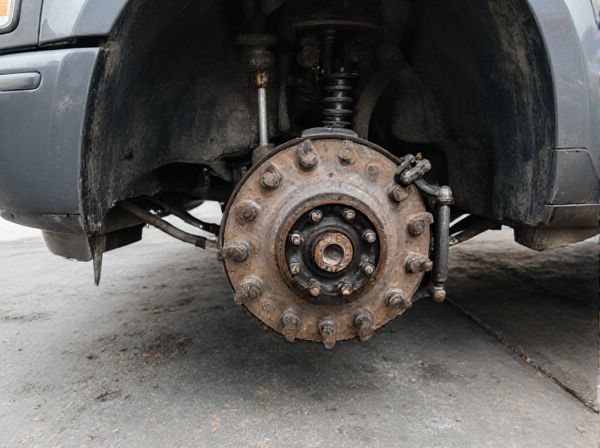
Photo illustration: Truetrac vs Posi-Traction
Truetrac and Posi-Traction are popular limited-slip differentials designed to improve traction by distributing power effectively between wheels. Truetrac uses helical gears for smooth, maintenance-free operation without clutches, providing consistent performance in various driving conditions. Your choice depends on whether you prefer the quieter, low-maintenance running of Truetrac or the clutch-based, aggressively locking performance of Posi-Traction.
Table of Comparison
| Feature | Truetrac | Posi-Traction |
|---|---|---|
| Type | Helical Gear Limited Slip Differential | Clutch-Type Limited Slip Differential |
| Performance | Smooth, instant torque transfer with no binding | Torque transfer with some clutch wear and possible chatter |
| Maintenance | Maintenance-free, no clutch replacements needed | Requires periodic clutch pack replacement |
| Durability | High durability due to gear-driven mechanism | Moderate, clutches wear over time |
| Noise | Quiet operation | May produce noise during engagement |
| Traction | Excellent in various driving conditions | Good, but less consistent than Truetrac |
| Installation | Direct bolt-in replacement for many models | Also direct bolt-in, widely available |
| Common Applications | Performance street, off-road, racing | Street performance and mild off-road |
Introduction to Truetrac and Posi-Traction
Truetrac is a helical gear limited-slip differential that uses a distinctive spiral gear design to provide smooth, automatic torque transfer between wheels, enhancing traction without the need for clutches or springs. Posi-Traction, a clutch-type limited-slip differential, employs clutch packs that engage under slip conditions to distribute torque evenly but can generate more wear and require maintenance over time. Truetrac offers quieter operation and reduced maintenance compared to traditional Posi-Traction differentials, making it a preferred choice for enthusiasts seeking reliable traction improvement.
Overview of Limited Slip Differentials
Truetrac and Posi-Traction are prominent types of limited slip differentials designed to enhance traction by distributing torque between wheels. Truetrac employs helical gears for smooth, automatic torque biasing without clutch engagement, providing quiet operation and durability. Posi-Traction relies on clutch packs to limit slip, offering firm traction but requiring maintenance due to wear on clutch components.
How Truetrac Works
Truetrac operates using helical gears instead of clutch plates or cones, allowing for smooth, automatic torque transfer without binding or chatter. This design enables the Truetrac to provide full torque to the wheel with the most traction, enhancing vehicle control on slippery surfaces. By using helical gears, Truetrac delivers reliable performance with quieter operation and less wear compared to Posi-Traction's clutch-based limited-slip differential.
How Posi-Traction Functions
Posi-Traction functions as a limited-slip differential that transfers torque to the wheel with the most traction by using clutch packs inside the differential housing, which engage to prevent one wheel from spinning freely. This mechanical system enhances traction during acceleration, especially on uneven or slippery surfaces, by distributing power more evenly across the driven wheels. Unlike Truetrac's helical gear design, Posi-Traction relies on friction-based clutches to manage torque transfer effectively.
Performance Comparison: Truetrac vs Posi-Traction
Truetrac offers superior off-road traction and smoother on-road performance compared to Posi-Traction, thanks to its helical gear design that provides consistent torque distribution without binding. Posi-Traction relies on clutch plates that can wear out, leading to reduced efficiency and less effective torque transfer during high-stress conditions. In terms of durability and maintenance, Truetrac's gear-driven mechanism requires less upkeep and delivers more reliable performance in demanding driving environments.
Durability and Maintenance Differences
Truetrac differentials use helical gears that provide continuous torque distribution without wearing clutch packs, ensuring higher durability and requiring minimal maintenance compared to Posi-Traction systems. Posi-Traction uses clutch plates that wear over time, demanding periodic adjustment and replacement to maintain optimal performance. This fundamental design difference gives Truetrac a longer service life with fewer maintenance interventions.
Pros and Cons of Truetrac Differentials
Truetrac differentials offer superior on-road traction thanks to their helical gear design, which provides smooth, noise-free operation and requires no maintenance or clutches. They excel in day-to-day driving conditions with improved handling and less drivetrain wear compared to Posi-Traction, which relies on clutch packs that can wear out and cause chattering noises. However, Truetrac may offer less aggressive locking performance in extreme off-road or high-torque scenarios where Posi-Traction's mechanical lock-up delivers more consistent traction.
Advantages and Disadvantages of Posi-Traction
Posi-Traction, a mechanical limited-slip differential, offers enhanced traction by distributing torque to the wheel with more grip, improving handling and stability on slippery surfaces. Its advantages include lower cost, simpler design, and reliable performance in moderate off-road or wet conditions. However, disadvantages include faster wear of clutch plates, potential noise during operation, and less effective torque transfer compared to modern electronic or locking differentials like Truetrac.
Cost and Installation Considerations
Truetrac offers a maintenance-free design with a higher initial cost compared to Posi-Traction, which is generally more affordable but may require regular upkeep. Installation of Truetrac is simplified by its gear-driven system, reducing long-term labor expenses, while Posi-Traction involves clutch packs that can complicate the installation process and demand precise adjustments. Evaluating total ownership costs reveals Truetrac's upfront investment can be offset by reduced maintenance and easier installation, making it a cost-effective solution for heavy-duty use.
Choosing the Right Differential for Your Vehicle
Choosing the right differential between Truetrac and Posi-Traction depends on your vehicle's performance needs and driving conditions. Truetrac, a helical gear type, provides smooth, automatic torque biasing without clutches, enhancing traction in off-road or slippery environments. Posi-Traction, a clutch-based limited-slip differential, offers reliable torque transfer under moderate conditions but may require maintenance and can cause slight drivetrain binding during tight turns.
 caratoz.com
caratoz.com